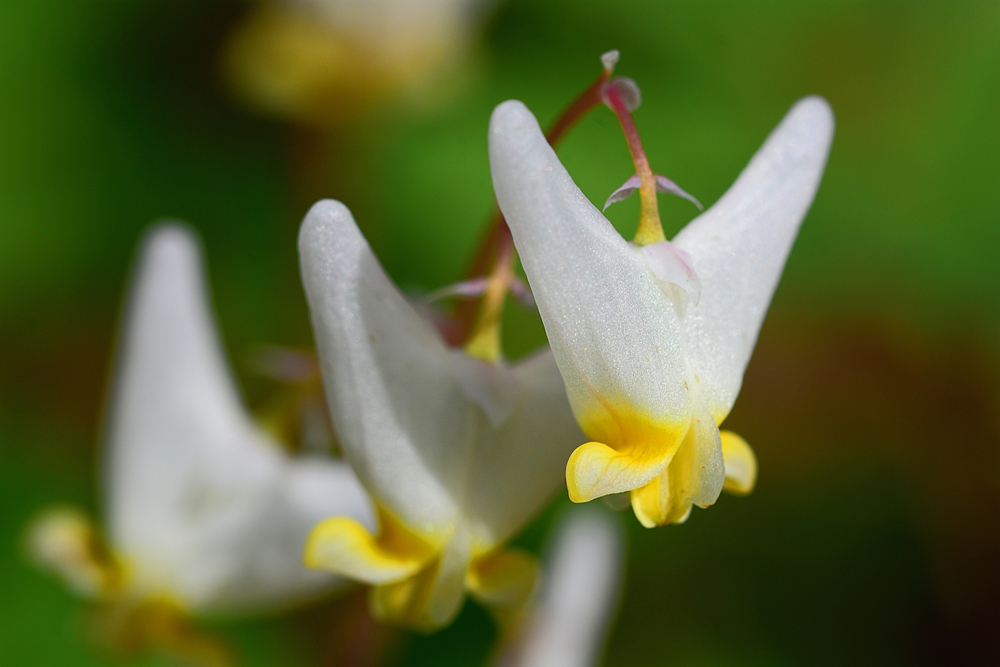
First Signs of Spring, Episode One: Spring Ephemerals
Welcome to “First Signs of Spring,” a mini-series covering different signs of spring in the Northwoods. Spring in the Northwoods is always one of my favorite times of the year. Life is awakening from its dormant state. It’s the beginning of longer and warmer days, with birds singing, trees budding, and flowers blooming. In Wisconsin, there are some telltale signs that spring is truly upon us, and one of these signs is the presence of spring ephemerals. Spring ephemerals are plants that emerge in the spring, typically within the months of March through May, only to quickly die off afterward. The word ephemeral comes from the Greek term “Ephemeros,” meaning “to last a day.” They are usually found in the rich soils of woodlands, bogs, and stream banks, taking in all of the sunlight before tree’s leaves begin to bud and cover the forest floor in shade.
Due to their early appearance, short lifespan, and the lack of other blooming plants in early spring, spring ephemerals have multiple symbiotic relationships not just with early pollinators but with other insects and even mammals as well. A symbiotic relationship is when both parties involved benefit from the relationship. For example, almost every spring ephemeral has a symbiotic relationship with ants to increase the chance of germination of their seeds. Spring ephemeral seeds have a fleshy-like structure attached to them that attracts ants to the plant. This fleshy-like structure is known as elaiosome. Elaiosome is rich in lipids and proteins, an ideal meal for ant larvae. The ants will feed the elaiosome to their larvae, discarding the unharmed seeds thus allowing them to germinate. Now that we have an overview of spring ephemerals let’s take a closer look at three of Wisconsin’s most iconic ones: the Trout Lily, Dutchman’s Breeches, and White Trillium.
Trout Lilies are a perfect example of a spring ephemeral that relies heavily on ants to keep the plant’s population growing. Trout Lily is a yellow woodland wildflower that gets its name due to the leaves of the plant resembling the colors of Brook Trout. This wildflower is often seen in large colonies, creating a dense carpet on the forest floor. They are found near bogs and stream banks, and some colonies can be as old as 150 years! They bloom between March and May, with the flower only lasting roughly two weeks.
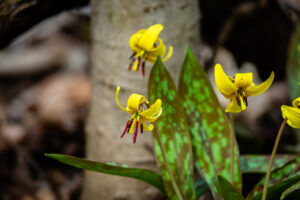
Even with such a short flowering season, it can take up to seven years for a Trout Lily to produce its first flower, making it even more fascinating that a colony can thrive over 100 years. Besides coloring the forest floor, colonies of Trout Lilies play an important role in preventing runoff. They have very efficient photosynthetic abilities, which requires a lot of water for the plant to process. With the combination of living in colonies and their requirement to absorb higher quantities of water, Trout Lilies prevent runoff when other plants are still dormant.
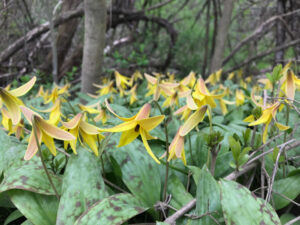
Dutchman’s Breeches is a unique spring ephemeral that gets its name due to the flower resembling a pair of breeches hanging upside down on a close line. Being part of the poppy family, another name that this spring ephemeral goes by is Little Blue Staggers because cattle have been known to stumble about after consuming this flower. Just like every other spring ephemeral flower, Dutchman’s Breeches plays an important role for early pollinators. What makes Dutchman’s Breeches stand out from all the others is that it relies solely on Queen Bumble Bees to pollinate them. Due to how deep the nectar is inside the flower, only insects with long tongues, such as bees and butterflies, have the ability to reach the nectar.
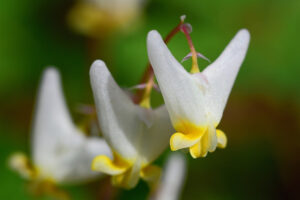
However, the way in which the Queen Bumble Bee retrieves the nectar is game-changing for Dutchman’s Breeches. Unlike all other long-tongued pollinators that will find or create holes within the spur of the plant (the hollow extension of the flower) to lap up the nectar, Queen Bumble Bees will pry the petals of the flower open to climb inside of the flower to reach the nectar. While she is about waist-deep inside the flower, pollen is transferred onto her. When she then goes to another flower, the pollen is dispersed onto the plant’s stigma (part of the female reproductive system found in the center of the flower), pollinating the plant. This is another perfect example of a symbiotic relationship with a spring ephemeral flower!
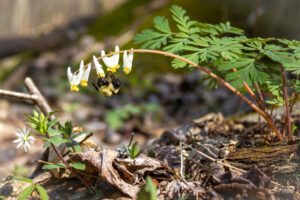
White Trillium is one of 50 of the species of Trillium, but in Wisconsin, White Trillium is the most abundant. All species of Trillium have three leaves, three petals, and three stigmas; the only difference between them is the variation in colors. Trilliums are phototropic plants, meaning the flowers follow the sun as it moves across the sky. White Trillium has several different names, such as Birthroot, Birthwort, and Wakerobin.
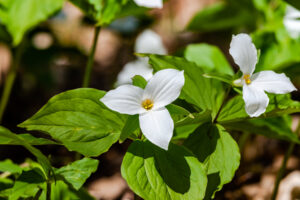
The names Birthroot and Birthwort were derived from indigenous people who used it during childbirth. The plant contains a chemical compound that acts as an antiseptic, coagulant, and induces labor. The name Wakerobin is due to their appearance right before American Robins return to their breeding grounds. This spring ephemeral prefers shady areas with partial light and is one of the more sensitive flowers due to the high chance of not being able to regrow after the flowers have been picked. Even though one White Trillium plant can live up to 25 years, it takes up to 10 years to produce its first flower, making them an even more delicate species. White-tailed Deer love to graze on these flowers, and although this might seem harmful since they are consuming the flowers, the deer unintentionally help plant new White Trillium. They do this by you guessed it, their feces. Once the flower has made its way into the digestive tracts of the White-tailed Deer, the seeds keep on moving right through the deer, and into their feces, helping the White Trillium to grow elsewhere.
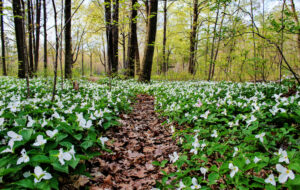
Now that spring is just around the corner, keep an eye out for these spring ephemerals. Not only are they an indicator of spring, but they are extremely important to our early pollinators. We hope that you enjoyed the first episode of our “First Signs of Spring” mini-series and stay tuned for next week when we talk about the early birds of spring.
Thank you to the following sources for the information for this post:
10 things you may not know about trilliums | kawarthaNOW
Dutchman’s Breeches | Dicentra cucullaria (wildadirondacks.org)
Beyond the Beauty of Spring Ephemerals – Schlitz Audubon
Wisconsin Native Spring Ephemerals | Johnson’s Nursery | KB (jniplants.com)
Dutchman’s Breeches – CornellBotanicGardens
Putnam Park Wildflower Walk | University of Wisconsin-Eau Claire Foundation (uwec.edu)